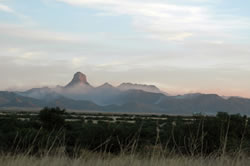Forests and Rangelands Success Story
Pre-Planning and Fire Policy Improves Management of Wildfire
U.S. Fish and Wildlife Service, Arizona
Healthy Forests - Fuels Reduction
2010

Smoke lingers on the horizon after a wildfire burned in Brown Canyon at Buenos Aires National Wildlife Refuge. Credit: U. S. Fish and Wildlife Service.
Recognizing that fire has a large role in shaping plant communities and influencing wildlife in deserts such as the Altar Valley near Tucson, Arizona, firefighters at Buenos Aires National Wildlife Refuge have been using fire as a restoration tool in the valley since the late 1980s. Prescribed burns are planned each year for various parts of the refuge to reduce the risk to nearby communities and to enhance and restore wildlife habitat of the Sonoran semi-desert grasslands. Fire managers and biologists have used the understanding of fire’s historical role on the landscape, as well as current conditions, to guide decisions about when, where, and how often to use prescribed fires.
Recently, the refuge began to plan prescribed burning in the Baboquavari Mountains which surround the valley. Fire had been suppressed in the mountains for decades. Specifically, the Service looked at Brown Canyon for opportunities to use fire to reduce the risk of losing buildings and infrastructure to unplanned wildfire, to enhance habitat, and to protect unique natural resources to unplanned wildfire. Fire managers can control fire behavior and its effects by selecting when and where to start the burn making a prescribed burn considerably less expensive to manage than a large wildfire.
Planning for the project was completed and the burn was set to be lit early in the summer of 2009. Because the weather conditions and personnel availability could not be met to support the plan to ignite the burn, it had to be postponed for a year. However, a wildfire started just north of Brown Canyon that summer.
By using the information gathered during the pre-planning that had taken place for the prescribed fire, firefighters were able to quickly determine safe and efficient suppression tactics to bring the fire under control. Refuge fire managers also used the information to manage this fire for multiple resource benefits under the revised guidance to the federal Interagency Fire Management Policy (2009). This allowed the fire to serve a more natural role resulting in the restoration of native grasslands. Negative impacts such as changes in the appearance of the landscape and reduced wildlife use of burned areas will be short lived; the long-term effects of the fire will be positive.